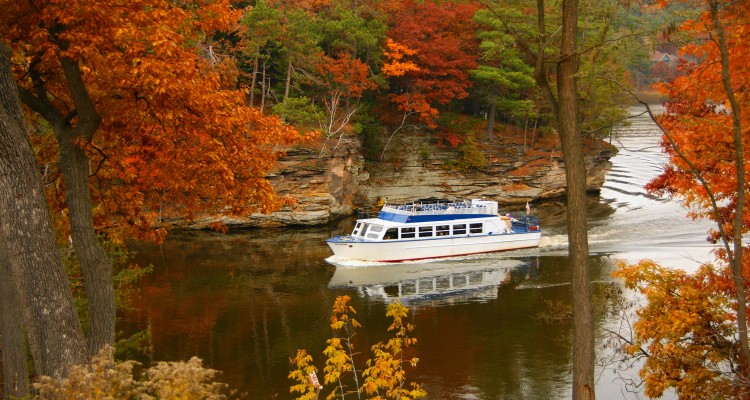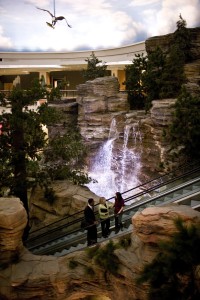
The Formation | The Draw | The Shift | The Future
The Formation

Photo Credit: Wisconsin Dells Visitor and Convention Bureau
A majestic eagle flies overhead into the light blue skies swirled with marshmallow clouds, while water dances off the golden sandstone cliffs into a pool surrounded by deep green trees. The sound of rushing water plays a never-forgotten tune.
Touch the rock, the sandstone that has given the Wisconsin Dells its name. But instead of a rough surface, you will feel painted cement underneath your hand. Feel the leaves between your fingers. The texture will remind you of the colorful cloth flowers from craft shops.
Even the sound of flowing water does not come from nature’s rhythms but from an electronic fountain, as slot machines ding in the distance. In lieu of the smells of decomposed leaves and fresh water is the lingering stench of stale cigarettes. Pink, yellow and blue lights shift hues against the rocks, creating the appearance of a sunset indoors.
An escalator runs through the layered rocks—formations similar to those that gave the Dells its renown—up to the convention center of the Ho-Chunk Casino in Baraboo, Wisconsin.
The casino holds the name of a tribe that used to be one of the most powerful of all American Indian nations, which used to roam the waters of the Wisconsin Dells freely, long before massive waterparks brought economic success to the Dells.
The intricate history of the Wisconsin Dells is a tale often overlooked. The former land of the Ho-Chunk Nation, this eight-mile gorge of magnificent exposed sandstone carved long ago by the Wisconsin Glacial Episode. The history of the Wisconsin Dells can be found quite literally in the water; you just have to look for it.
[youtube https://www.youtube.com/watch?v=ZZE1l4gbinY]
Thick layers of jagged yellow and brown sandstone dart out along the flowing Wisconsin River, a river that has flowed through the Dells for more than 14,000 years. This water is a part of the Ho-Chunk, a tribe formerly known as the Winnebago, derived from a Meskwaki word meaning the “People of the Stinking Water.”
A spiritual connection to the water flows through the oral history of the Ho-Chunk.
“Our people would camp out here on their annual migrations from northern villages to the southern lodges,” Lance Tallmadge, a Ho-Chunk tribal member, says in the Thunder in the Dells documentary. “They would meet in the Wisconsin Dells because of the force of the river, the rocks, and they would utilize this area to renew themselves physically because of the hard journey, but also spiritually because of the force of the nature here.”
In the 1940s, Ho-Chunk tribal member Albert Yellow Thunder spoke to the renewal and rejuvenation the Ho-Chunk found in the alluring landscape.
“My people come here because of the rock images, the enchantment of the canyons, the evergreen banks, the winding river,” he says. “Their hearts are made free by the things they see and feel and smell.”
At the heart of this was water, a feature of the landscape that would go on to give the Dells the title “Waterpark Capital of the World.”
As if by fate, hundreds of thousands of years ago, a massive ice sheet swept through the state from Green Bay to the Baraboo Hills and suddenly stopped a few miles short of the Upper Dells due to the highlands of southwestern Wisconsin. The glacial drift rendered the landscape flat, creating the plethora of glimmering lakes that dominate the area today.
“If it wasn’t for this sudden halt, the land we know today would have been completely submerged in water,” says Wisconsin Dells boat tours guide Harlan Feldt. “No one would have ever known its glorious natural wonders ever existed.”
Dells Boat Tour Guide Harlan Feldt explains the sandstone formation.
The Cambrian sandstone rock that crafts the Dells’ unique landscape formed well before tourists set foot in the Dells, well before boats crowded the river and waterparks framed the skyline. More than 500 million years ago, this rock, which is the oldest and softest rock on the face of the planet, took shape from ancient sand dunes.
Although the soft calcite crystals are what keep the sand together, the sand grains are pure quartz, one of the hardest substances found on the face of the earth. The cementing agents weakly glue the sand together, allowing expansion for plants to grow and thrive. The natural resources are all nourished by the caramel-colored water, tinted by tannic acid. The monumental oak trees that reside in the land produce tannins that seep into the river water, creating the natural color the water is known for.
While the brown river continues to flow through the Dells today, one thing is missing—the Ho-Chunk. The tribe was forcibly removed from the land their ancestors treasured, from the winding river and sandstone formations. Instead, tourists have taken their place, taking boat tours and ogling the river’s abundance of sights and splendors, aided by businesses that have found refuge near the water the Ho-Chunk deemed so sacred.

